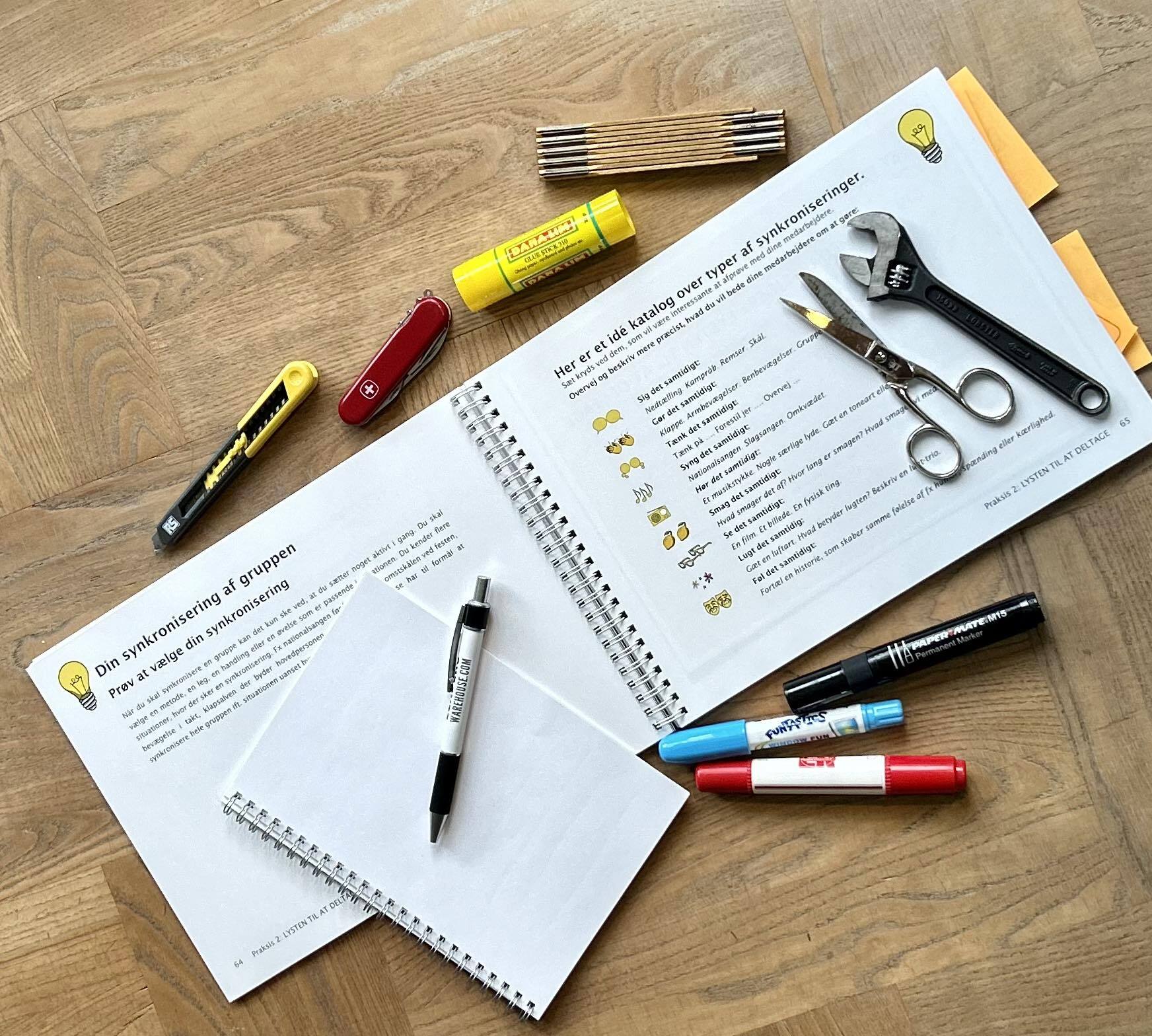- RECIPES FOR EXERCISES & WORKSHOPS
- TRAINING & WORKSHOPS WITH FILMS
- MEETING GADGETS & ACCESSORIES
- COOL TEAM TOOLS
-
SAMPLE BOXES

- STARTER KITS
-
BOOKS & POSTERS

-
FISH! CULTURE: Ready to Make Work Feel Better?
- TRAINING & WORKSHOPS
- TEAM TALK DIY
- LEAD YOUR TEAM
- LEAD YOUR LEADERS
- LEAD YOUR MEETINGS
- MEINHARDTS LEADERSHIP BLOG
Pick up a recipe
Many workshops, exercises and training courses follow a recipe and a model. This recipe is good to follow so that you don't forget important points, main messages, dialogue, involvement, testing, plan, underlines, brainstorming, etc.
Here are a number of recipes that you can follow slavishly or change completely according to your wishes. The recipes also recommend some tools that you can download or purchase.
The purpose of a workshop/course is for the participants to learn more together on a specific topic or issue.
The topic can be, for example, getting better at praising and recognizing, serving customers, managing employees, surviving in the wilderness, gaining psychological freedom.
The topic can also be, for example, making new internal agreements about cooperation, about culture, about saying what you want to do and doing what you say, about prejudice, about retaliation, about the plan for a good meeting.
Regardless of the topic, you can put together a plan that inspires, motivates and gives the participants so much blood on their teeth that they actually start to use the new and even tell others about their new insights.
In general, for all 'gatherings' where people should preferably show up, - it is important for the further work of the group that the start is extremely important. It always starts with an invitation.
Invite them
All events, meetings, courses, parties, etc. start with an invitation.
'I would be happy to see you on Thursday at 3 pm for an informal meeting.'
You can reveal more or less about the content. It can be too detailed and it can also be too undetailed. The invitation should contain enough information to make people want to show up and even look forward to it. If there is a requirement to attend, you should also write that. But that is why the meeting can be both fun and serious.
There are countless ways to invite. Email, SMS, phone, letter, fireworks, a short film. Find a proportion that suits or surprises appropriately.
If you invite them, the chance that they will show up and want to participate is the greatest. The joy of anticipation, a little preparation, a little involvement.
If you don't invite them, the chance that they will stay away is the greatest. Maybe they will show up but not be mentally present.
Synchronize them
I once arrived at a lecture where about 300 people who did not know each other showed up.
Outside the door stood a man with a basket full of eggs, rhythm eggs it was. The man welcomed me and gave me an egg. I walked into the room and there was a fairly large group of people making a rhythm with their rhythm eggs. I didn't want to stand out, so I started to beat the same rhythm with my egg. Suddenly I was part of the group. As I sat down, I looked around. There was nothing but smiles and nods and recognition. We all sat like that until a person stepped forward and began the presentation, which was about something with presentations.
A fantastic start. A synchronizing start. Synchronization can take a myriad of forms. Shake hands with everyone at the entrance. Start with a song. A countdown. A quick name-calling round. People and employees and children and guests and visitors are always individuals when they arrive. If you, as a manager, want them to be a group, then you have to synchronize them. Everything gets easier from here.
If you synchronize them, you turn a bunch of individuals into a 'community'. Every morning they show up, every time a new meeting starts, every time they show up for the 'gathering', they are individuals.
If you don't synchronize them, they remain isolated individuals. Why should they get involved? Why should they care? Why should they listen?
Involve them
You can talk them all to sleep and never let them speak. This will certainly result in a boring meeting, a dead-end workshop or an exercise that is only interesting to the leader. You have to subject them to one or more tests.
All tests start with you asking them to follow you out onto the floor, onto the grass, into the hallway - that is, away from the safe chair they are sitting in and where they know the person next to them. There 'out' you can, for example, lay out the picture cards on the floor, distribute handouts or put out a long rope. Then you can explain why you are standing here and what you are going to do. You may have to ask them to stand in a certain way, a large circle, in pairs 1 meter apart or in 2 rows facing each other.
Only now does the actual exercise begin. This exercise is for everyone to try roughly the same thing, will be able to react and will be asked to make suggestions on how to avoid or increase.
For example, I often use an exercise called 1, 2, 3. It is actually an old game where two people stand opposite each other and take turns saying a number. One starts and says 1. Then the other says 2. Then the first says 3. Then the other says 1. And they continue counting like that. Both have to keep their tongues straight in their mouths. Then I stop them and ask them to replace 1 with a clap with their hands. Then the exercise is called clap, 2, 3. And you still have to concentrate a lot. When they manage to do that, the game continues by replacing 2 with a stomp with one foot on the floor. Then the exercise is called clap, stomp, 3. And now you have to concentrate extra hard. When they both can do that, the game continues by replacing 3 with a word - any word, a slogan, a rallying cry, a company name. Then the exercise is called clap, stomp, FOR DANMARK.
Now everyone has tried 1, 2, 3. It took about 3 minutes. And it was both fun and educational. Now it's time to ask them: What did we practice here? The first answers are always: 'Playing'. Then I say: That's a very good answer. But imagine that your CEO comes through the door while we're standing there clapping and stomping and says: What are you doing?
Then the participants' answers get a little better: 'We practice concentrating.' 'We collaborate.' 'We become good at teamwork.'
Then I continue a little with the CEO, who asks: 'Is there money in it?'
And that way we all learn a little more about a game that is both fun and serious. A game is not just for children. A game can also be development at a fairly high level, so that we all become better at what we do.
If you involve them, they become interested. If you involve them, the curiosity, the commitment, the desire starts.
If you don't involve them, you can read it in their eyes. They slide further down in their seats. They are unfocused.
What?
There is always a wise head in the group who asks the question: 'What should we do with it?' So you might as well ask it yourself. Sometimes you can ask the question to the whole group: 'Yes, a really good question, why should we try it?' You will certainly get several good answers and suggestions for what you tried. See how to get the participants to come up with suggestions in the section above.
So what?
This question can be elaborated on a bit. Now we have tried it and what do we do with the knowledge we now have? It pays to practice concentrating. Does this give everyone permission to play, practice something and thus get better?
So what?
Should, what we have now tried and talked about, lead to new things, changes, modifications, adjustments? And which ones? Who needs to know? Who needs to do it?
Thank you
Remember to thank those who need to be thanked. Thank you for the level of involvement and commitment. Thank you for their ideas and input. Thank you for their patience.
Tell them what will happen next and how much better your daily life, the company and the world will be because of your invested efforts.




